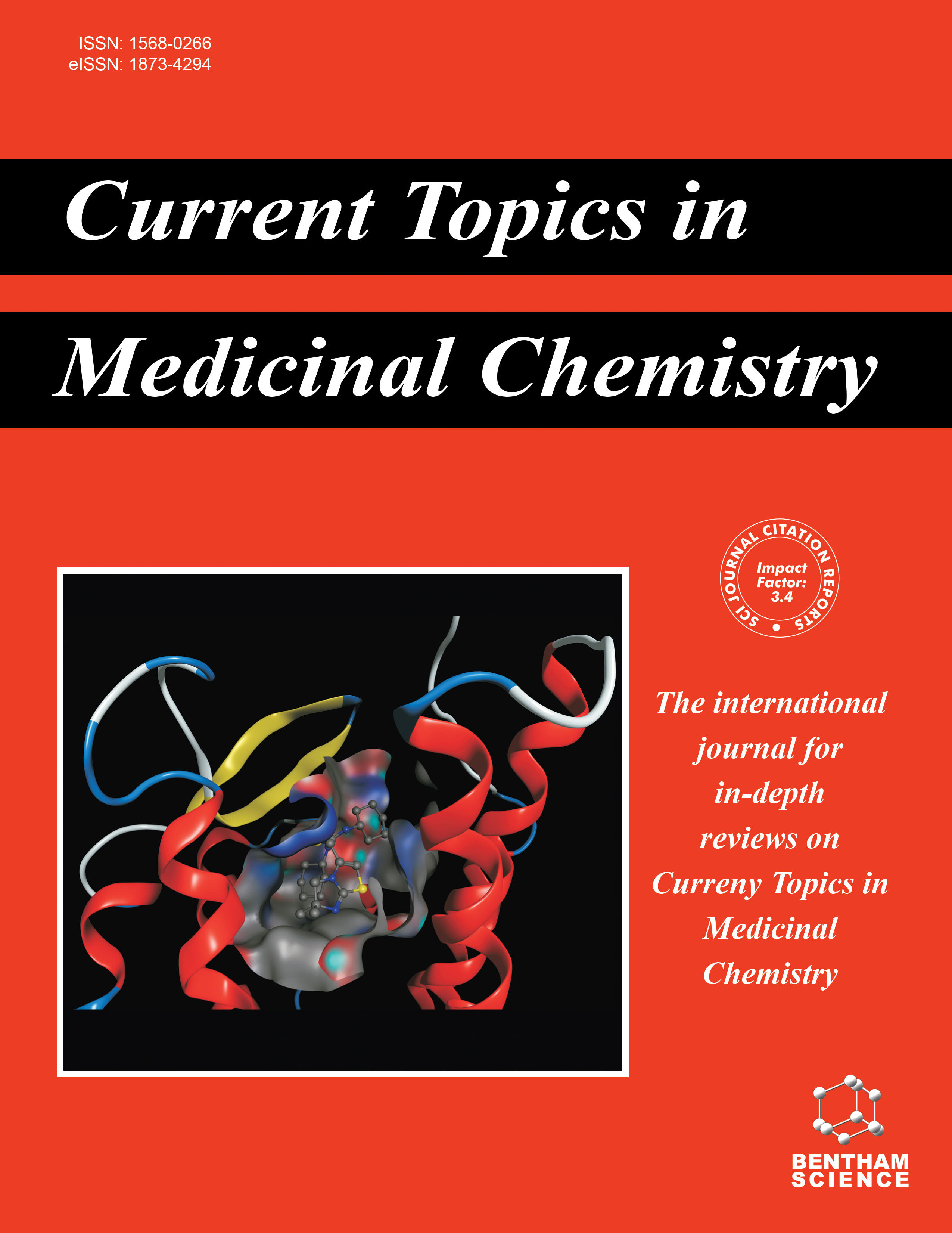- Home
- A-Z Publications
- Current Topics in Medicinal Chemistry
- Previous Issues
- Volume 16, Issue 13, 2016
Current Topics in Medicinal Chemistry - Volume 16, Issue 13, 2016
Volume 16, Issue 13, 2016
-
-
Advances in the Development of Class I Phosphoinositide 3-Kinase (PI3K) Inhibitors
More LessAuthors: Dima A. Sabbah, Jian Hu and Haizhen A. ZhongThe PI3K signaling cascade is the key moderator of cell proliferation, survival, motility, and apoptosis. Class I PI3K proteins are well characterized and linked to thrombosis (PI3Kβ), rheumatoid arthritis (PI3Kδ), and cancer (PI3Kα). In this review, we explore the latest progress in the design and development of selective Class I PI3K inhibitors from the perspective of drug design and structure activity relationships.
-
-
-
Targeting the Atypical Chemokine Receptor ACKR3/CXCR7: Phase 1 - Phage Display Peptide Identification and Characterization
More LessAuthors: R.D. Vestal, D.R. LaJeunesse and E.W. TaylorOne of the greatest challenges in fighting cancer is cell targeting and biomarker selection. The Atypical Chemokine Receptor ACKR3/CXCR7 is expressed on many cancer cell types, including breast cancer and glioblastoma, and binds the endogenous ligands SDF1/CXCL12 and ITAC/CXCL11. A 20 amino acid region of the ACKR3/CXCR7 N-terminus was synthesized and targeted with the NEB PhD™-7 Phage Display Peptide Libra Read More
-
-
-
Drug Design Targeting the CXCR4/CXCR7/CXCL12 Pathway
More LessAuthors: Dongsheng Xu, Rongshi Li, Jianguo Wu, Li Jiang and Haizhen A. ZhongUnder physiological conditions, CXCL12 modulates cell proliferation, survival, angiogenesis, and migration mainly through CXCR4. Interestingly, the newly discovered receptor CXCR7 for CXCL12 is highly expressed in many tumor cells as well as tumor-associated blood vessels, although the level of CXCR7 in normal blood cells is low. Recently, many studies have suggested that CXCR7 promotes cell growth and metastasis in variou Read More
-
-
-
Cheminfomatic-based Drug Discovery of Human Tyrosine Kinase Inhibitors
More LessAuthors: Terry-Elinor Reid, Joseph M. Fortunak, Anthony Wutoh and Xiang Simon WangReceptor Tyrosine Kinases (RTKs) are essential components for regulating cell-cell signaling and communication events in cell growth, proliferation, differentiation, survival and metabolism. Deregulation of RTKs and their associated signaling pathways can lead to a wide variety of human diseases such as immunodeficiency, diabetes, arterosclerosis, psoriasis and cancer. Thus RTKs have become one of the most important drug targ Read More
-
-
-
Receptor-based 3D-QSAR in Drug Design: Methods and Applications in Kinase Studies
More LessAuthors: Cheng Fang and Zhiyan XiaoReceptor-based 3D-QSAR strategy represents a superior integration of structure-based drug design (SBDD) and three-dimensional quantitative structure-activity relationship (3D-QSAR) analysis. It combines the accurate prediction of ligand poses by the SBDD approach with the good predictability and interpretability of statistical models derived from the 3D-QSAR approach. Extensive efforts have been devoted to the d Read More
-
-
-
Methionine AminoPeptidase Type-2 Inhibitors Targeting Angiogenesis
More LessAngiogenesis has been identified as a crucial process in the development and spread of cancers. There are many regulators of angiogenesis which are not yet fully understood. Methionine aminiopeptidase is a metalloenzyme with two structurally distinct forms in humans, Type-1 (MetAP-1) and Type-2 (MetAP-2). It has been shown that small molecule inhibitors of MetAP-2 suppress endothelial cell proliferation. The initial discover Read More
-
-
-
G Protein Coupled Receptors And Structure-Based Advances
More LessG protein coupled receptors (GPCRs) are membrane proteins coupled with G proteins through which they transmit signals to the cytoplasm. Approximately 30% of pharmaceuticals target these receptors, even though crystal structures were scarce at the time. Furthermore, an additional 15% of GPCRs have yet to be exploited for therapeutic intervention. An overview of structural information is presented, with emphasis o Read More
-
-
-
Development of Trypsin-Like Serine Protease Inhibitors as Therapeutic Agents: Opportunities, Challenges, and their Unique Structure-Based Rationales
More LessAuthors: Guyan Liang and J. Phillip BowenThere has been a revolution in the development of effective, small-molecule anticoagulants and antiplatelet agents. Numerous trypsin-like serine proteases have been under active pursuit as therapeutic targets. Important examples include thrombin, factor VIIa, factor Xa, and β-tryptase with indications ranging from thrombosis and inflammation to asthma and chronic obstructive pulmonary disease (COPD). Trypsin-like serine Read More
-
-
-
Cellular Selenoprotein mRNA Tethering via Antisense Interactions with Ebola and HIV-1 mRNAs May Impact Host Selenium Biochemistry
More LessAuthors: Ethan Will Taylor, Jan A. Ruzicka, Lakmini Premadasa and Lijun ZhaoRegulation of protein expression by non-coding RNAs typically involves effects on mRNA degradation and/or ribosomal translation. The possibility of virus-host mRNA-mRNA antisense tethering interactions (ATI) as a gain-of-function strategy, via the capture of functional RNA motifs, has not been hitherto considered. We present evidence that ATIs may be exploited by certain RNA viruses in order to tether the mRNAs of host seleno Read More
-
Volumes & issues
-
Volume 25 (2025)
-
Volume 24 (2024)
-
Volume 23 (2023)
-
Volume 22 (2022)
-
Volume 21 (2021)
-
Volume 20 (2020)
-
Volume 19 (2019)
-
Volume 18 (2018)
-
Volume 17 (2017)
-
Volume 16 (2016)
-
Volume 15 (2015)
-
Volume 14 (2014)
-
Volume 13 (2013)
-
Volume 12 (2012)
-
Volume 11 (2011)
-
Volume 10 (2010)
-
Volume 9 (2009)
-
Volume 8 (2008)
-
Volume 7 (2007)
-
Volume 6 (2006)
-
Volume 5 (2005)
-
Volume 4 (2004)
-
Volume 3 (2003)
-
Volume 2 (2002)
-
Volume 1 (2001)
Most Read This Month
Article
content/journals/ctmc
Journal
10
5
false
en


